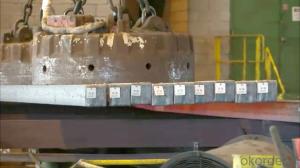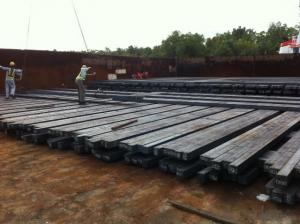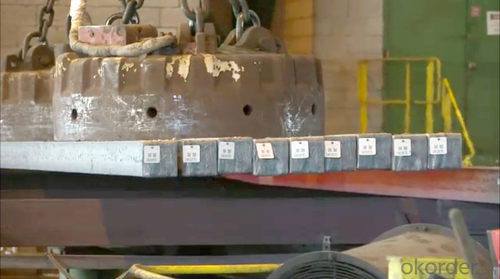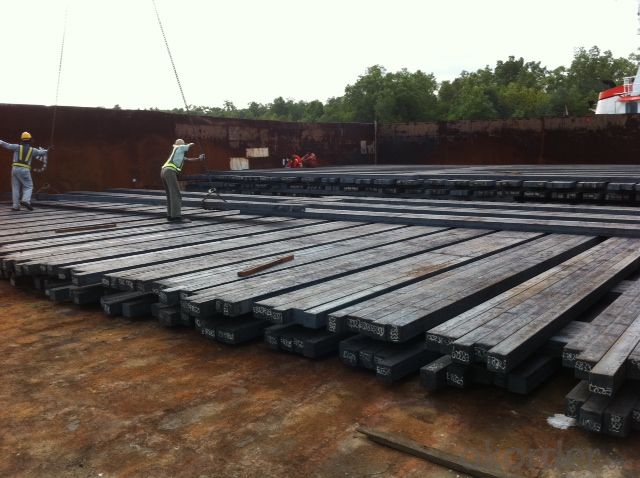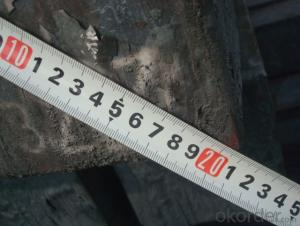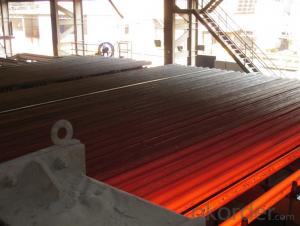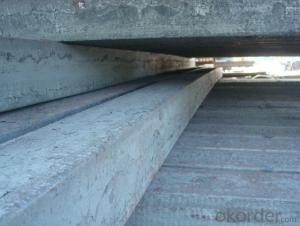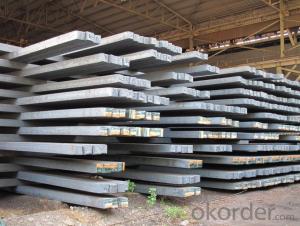Prime quality prepainted galvanized steel 730mm
- Loading Port:
- Tianjin
- Payment Terms:
- TT OR LC
- Min Order Qty:
- 100 m.t.
- Supply Capability:
- 10000 m.t./month
OKorder Service Pledge
OKorder Financial Service
You Might Also Like
Construction building material galvanized color prepainted cold
rolled steel coil
Prepainted steel sheet is coated with organic layer, which provides higher anti-corrosion property and
a longer lifespan than that of galvanized steel sheets.
The base metals for prepainted steel sheet consist of cold-rolled, HDG electro-galvanized and hot-dip
Alu-zinc coated. The finish coats of prepainted steel sheets can be classified into groups as follows:
polyester, silicon modified polyesters, polyvinylidene fluoride, high-durability polyester, etc
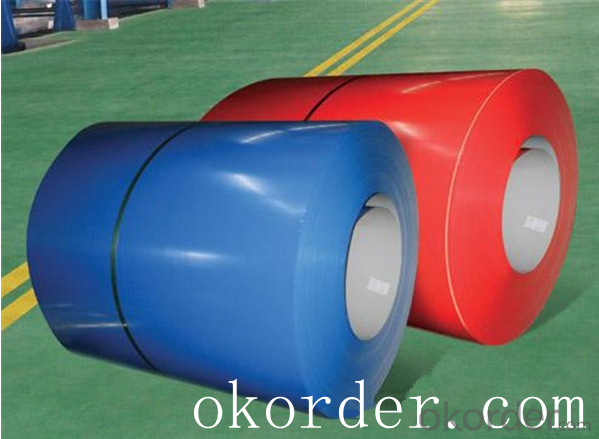
Standard and Grade :
Pre-paint galvanized steel coil | ||||
ASTM A755M-03 | EN10169:2006 | JISG 3312-2012 | ||
Commercial quality | CS | DX51D+Z | CGCC | |
Structure steel | SS GRADE 230 | S220GD+Z | CGC340 | |
SS GRADE 255 | S250GD+Z | CGC400 | ||
SS GRADE 275 | S280GD+Z | CGC440 | ||
SS GRADE 340 | S320GD+Z | CGC490 | ||
SS GRADE550 | S350GD+Z | CGC570 | ||
S550GD+Z | ||||
Application:
Outdoor | Roof, roof structure, surface sheet of balcony, frame of window, door of garage, rolled shutter door, booth, Persian blinds, cabana, etc |
Indoor | Door, isolater, frame of door, light steel structure of house, home electronic appliances, ect. |
Specifications
Commodity Name: Prepainted Galvanized Steel Coil
Standard: AISI, ASTM, DIN, GB, JIS
Grade: TDC52D+Z
Thickness 0.13-8.0mm
Width:600mm-1350mm
Zinc Coating:275g/m2
Polyester Coating Thickness:Top and Back coating thickness depend by Buyer Requirement.
Polyester Coating Type:2/2,1/2m,1/2.
Polyester Type: Polyester, silicone modified polyester, high durability polyester (HDP), polyvinylidene fluoride (PVDF)
Unit Roll Weight:5-20tons
Place of Origin Shanghai , China (Mainland)
Surface Treatment :Color Coated
Manufacture Progress:HRC-CRC-GALVANIZED-COLOR COATED
Application : Construction, electrical, transportation, steel plant, composite board plant, steel tile factory
Payment & Shipping Terms:T/T ,L/C, and FOB CHINA
Minimum Order Quantity: 25Tons
Packge Type: Moisture-proof paper inner,Steel outside,Bundle by steel rope.
Package in Container : Wood as a foot pad, wire rope reinforcement,PPGI steel coil tied together by steel rope.
- Q: What is the average lifespan of a steel billet in the automotive industry?
- The average lifespan of a steel billet in the automotive industry can vary depending on several factors such as the specific application, type of steel used, and maintenance practices. However, on average, steel billets in the automotive industry can last for several years to decades, especially when properly cared for and maintained.
- Q: Can steel billets be used in the automotive industry?
- Yes, steel billets can be used in the automotive industry. Steel billets are semi-finished steel products that are typically used for further processing into different shapes and forms. In the automotive industry, steel billets are commonly used for the production of various automotive components such as engine parts, transmission parts, chassis components, and suspension systems. The use of steel billets in the automotive industry offers several advantages including high strength, durability, and cost-effectiveness. Additionally, steel billets can be easily formed, machined, and welded to meet specific design requirements and performance standards in the automotive sector. Therefore, steel billets play a crucial role in the manufacturing of automobiles and contribute to the overall performance, safety, and reliability of vehicles.
- Q: How do steel billets contribute to the environmental sector?
- Steel billets contribute to the environmental sector in several ways. Firstly, the production of steel billets often involves recycling scrap metal, which helps reduce the demand for raw materials and conserves natural resources. This process also reduces the energy required for steel production, resulting in lower greenhouse gas emissions and a smaller carbon footprint. Furthermore, steel billets are widely used in construction projects, such as building infrastructure and renewable energy installations. Steel is a highly durable material that can withstand harsh weather conditions and has a long lifespan. By using steel billets in construction, we can create structures that require minimal maintenance and repair, reducing the need for frequent replacements and conserving additional resources. Additionally, steel billets play a crucial role in the manufacturing of eco-friendly products. Steel is a key component in the production of electric vehicles, wind turbines, and solar panels. These clean energy solutions help reduce our reliance on fossil fuels and decrease harmful emissions, thus contributing to a cleaner and greener environment. Moreover, steel billets can be recycled again at the end of their lifespan, further reducing waste and minimizing the environmental impact. Recycling steel is a highly efficient process that requires less energy and produces fewer emissions compared to the production of new steel from raw materials. In conclusion, steel billets contribute to the environmental sector through their recycling capabilities, durability in construction, and their role in the manufacturing of eco-friendly products. By incorporating steel billets into various industries, we can promote sustainability, conserve resources, and reduce our environmental footprint.
- Q: Can steel billets be used for making musical instruments?
- Yes, steel billets can be used for making musical instruments. While traditional musical instruments are often made from materials such as wood or brass, steel can also be used to create unique and modern instruments. Steel's strength and durability make it ideal for certain instruments, such as steel drums or steel guitars. Additionally, steel's versatility allows for the creation of intricate designs and shapes that can produce a wide range of sounds. However, it is important to note that the specific characteristics and properties of the steel used, such as its composition and thickness, will greatly impact the sound and quality of the instrument. Therefore, careful consideration and experimentation may be required to achieve the desired musical tones and effects when using steel billets for instrument making.
- Q: How are steel billets distributed in the market?
- Steel billets are distributed in the market through various channels and processes. These channels can be broadly categorized into three main methods: direct sales, through distribution networks, and online platforms. Direct sales involve manufacturers or steel mills selling their billets directly to customers, such as construction companies, fabricators, or steel service centers. This method allows manufacturers to have better control over pricing, quality, and delivery schedule. It also enables them to build direct relationships with customers and understand their specific requirements. Distribution networks play a significant role in the distribution of steel billets. These networks consist of wholesalers, distributors, and stockists who purchase steel billets from manufacturers and sell them to end-users or smaller retailers. Distribution networks have extensive market reach, allowing them to cater to a wide geographical area. They provide convenience to customers by maintaining an inventory of steel billets, ensuring timely availability and reducing lead times. In recent years, online platforms have emerged as a popular method for distributing steel billets. Online trading platforms connect buyers and sellers of steel billets, providing a convenient and efficient way to conduct business transactions. These platforms allow manufacturers to reach a global customer base, while buyers can access a wide range of suppliers and compare prices and specifications. Online platforms also provide transparency and reduce the need for intermediaries, resulting in cost savings. Regardless of the distribution method, the logistics of steel billets' transportation and storage are crucial. Steel billets are typically transported in bulk using various modes of transportation, including trucks, trains, or ships. To ensure the quality and integrity of the billets, proper storage facilities are necessary, which include warehouses or yards equipped with cranes and heavy-duty machinery. Overall, the distribution of steel billets involves a complex network of manufacturers, distributors, and online platforms, all working together to meet the diverse needs of customers. This ensures a steady supply of steel billets in the market, supporting various industries such as construction, manufacturing, and infrastructure development.
- Q: What are the different types of welding processes used for joining steel billets?
- When it comes to joining steel billets, there are various welding processes available, each with its own unique characteristics and advantages depending on the project's specific requirements. Here, we present some of the commonly used welding processes for joining steel billets: 1. Shielded Metal Arc Welding (SMAW), also known as stick welding, utilizes a consumable electrode coated in flux that creates an arc between the electrode and the base material. This versatile process can be used for both thick and thin steel billets, making it widely employed in various industries. 2. Gas Metal Arc Welding (GMAW), commonly referred to as MIG welding, involves a continuous wire electrode and a shielding gas that protects the weld from atmospheric contamination. This process offers high productivity and is suitable for welding steel billets of different thicknesses. 3. Flux-Cored Arc Welding (FCAW), similar to GMAW, employs a continuously fed tubular electrode filled with flux. It is particularly suitable for welding thicker steel billets and finds applications in heavy fabrication. 4. Gas Tungsten Arc Welding (GTAW), also known as TIG welding, utilizes a non-consumable tungsten electrode and a separate filler metal. This process produces high-quality welds and is commonly used in applications that require precision and aesthetic appeal. 5. Submerged Arc Welding (SAW) involves a continuously fed electrode and a granular flux that covers the weld area. It is particularly suitable for welding thick steel billets and is often used in the construction of pressure vessels and heavy machinery. 6. Laser Beam Welding (LBW) employs a laser beam to generate heat and join the steel billets. This process offers high precision and speed, making it suitable for a wide range of applications, including automotive and aerospace industries. 7. Electron Beam Welding (EBW) uses a high-velocity electron beam to melt and join the steel billets. This process provides deep penetration and precise control, making it ideal for critical applications that require high-quality welds. When selecting the appropriate welding process, it is crucial to consider the specific requirements, thickness, and material properties of the steel billets. Consulting with a welding expert can help determine the most suitable method for a given project.
- Q: How do steel billets contribute to the infrastructure development?
- The versatility and strength of steel billets make them an essential element in infrastructure development. These solid steel blocks serve as a fundamental raw material for building construction, bridge construction, and other infrastructure projects. An important way in which steel billets contribute to infrastructure development is through the production of reinforced concrete. Steel rebars, which are made from steel billets, are embedded in concrete to enhance its strength and durability. This reinforcement enables structures to withstand external forces, ensuring their long-term stability. Furthermore, steel billets are also utilized in the production of structural steel sections like beams, columns, and trusses. These components are crucial for constructing diverse types of infrastructure, including high-rise buildings and bridges. The incorporation of steel in such applications provides exceptional load-bearing capacity, enabling the construction of large and intricate structures. Steel billets also play a significant role in the manufacturing of pipes, which are a vital part of infrastructure systems such as water supply, sewage, and gas pipelines. Due to its strength and resistance to corrosion, steel is an ideal material for these applications, guaranteeing the integrity and longevity of the infrastructure network. Another noteworthy contribution of steel billets to infrastructure development is their use in the manufacturing of heavy machinery and equipment used in construction projects. Steel billets are utilized in constructing the frames and other structural components of machinery, ranging from cranes to excavators. This ensures that these machines possess the necessary strength and reliability for effective construction work. In conclusion, steel billets are indispensable for infrastructure development as they provide the required strength and durability for various construction applications. Whether it involves reinforcing concrete, manufacturing structural components, or constructing heavy machinery, steel billets play a crucial role in creating resilient and long-lasting infrastructure.
- Q: Refinery carbon 3 is propane, then carbon four carbon five is what name ah?.What are they used for?
- Carbon four is butane, which is made up of four carbon, divided into n-butane and isobutane.Carbon five is pentane, composed of five carbon, divided into pentane, isoamyl, and new pentane.A product of petroleum refining, usually consisting of alkanes with a greater number of carbon atoms.
- Q: Can steel billets be used in the production of jewelry?
- Steel billets are typically not used in the production of jewelry due to their composition and properties. Steel is an alloy primarily composed of iron and carbon, with additional elements such as manganese, chromium, and nickel. This composition gives steel its strength and durability, making it ideal for various industrial applications, but not for jewelry production. Jewelry is often crafted from precious metals like gold, silver, and platinum, which possess unique characteristics that make them suitable for adornment. These metals are malleable, meaning they can be easily shaped and molded into intricate designs. Additionally, they have a lustrous appearance and are resistant to tarnishing or corrosion. Steel, on the other hand, is much harder and less ductile compared to precious metals. It cannot be easily manipulated into delicate and intricate shapes required for jewelry making. Furthermore, steel has a dull gray color, which does not provide the desired aesthetic appeal in jewelry. While it is technically possible to create jewelry using steel billets, it is not a common practice due to the aforementioned reasons. Steel is primarily used in industries where its high strength and durability are necessary, such as construction, automotive, and machinery manufacturing.
- Q: Does anyone know how much it costs to refine a ton of steel? What are the expenses involved?
- Electricity, water, wages, raw materials, raw materials loss, charges, oxygen, according to their own circumstances, as well as freight and other expenses,
Send your message to us
Prime quality prepainted galvanized steel 730mm
- Loading Port:
- Tianjin
- Payment Terms:
- TT OR LC
- Min Order Qty:
- 100 m.t.
- Supply Capability:
- 10000 m.t./month
OKorder Service Pledge
OKorder Financial Service
Similar products
Hot products
Hot Searches
Related keywords
